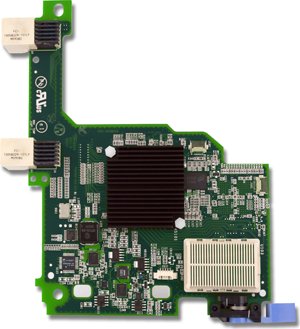 A few weeks ago, IBM and Emulex announced a new blade server adapter for the IBM BladeCenter and IBM System x line, called the “Emulex Virtual Fabric Adapter for IBM BladeCenter" (IBM part # 49Y4235). Frequent readers may recall that I had a "so what" attitude when I blogged about it in October and that was because, I didn't get it. I didn't get what the big deal was with being able to take a 10Gb pipe and allow you to carve it up into 4 "virtual NICs". HP's been doing this for a long time with their FlexNICs (check out VirtualKennth's blog for a great detail on this technology) so I didn't see the value in what IBM and Emulex was trying to do. But now I understand. Before I get into this, let me remind you of what this adapter is. The Emulex Virtual Fabric Adapter (CFFh) for IBM BladeCenter is a dual-port 10 Gb Ethernet card that supports 1 Gbps or 10 Gbps traffic, or up to eight virtual NIC devices.
A few weeks ago, IBM and Emulex announced a new blade server adapter for the IBM BladeCenter and IBM System x line, called the “Emulex Virtual Fabric Adapter for IBM BladeCenter" (IBM part # 49Y4235). Frequent readers may recall that I had a "so what" attitude when I blogged about it in October and that was because, I didn't get it. I didn't get what the big deal was with being able to take a 10Gb pipe and allow you to carve it up into 4 "virtual NICs". HP's been doing this for a long time with their FlexNICs (check out VirtualKennth's blog for a great detail on this technology) so I didn't see the value in what IBM and Emulex was trying to do. But now I understand. Before I get into this, let me remind you of what this adapter is. The Emulex Virtual Fabric Adapter (CFFh) for IBM BladeCenter is a dual-port 10 Gb Ethernet card that supports 1 Gbps or 10 Gbps traffic, or up to eight virtual NIC devices.
This adapter hopes to address three key I/O issues:
1.Need for more than two ports per server, with 6-8 recommended for virtualization
2.Need for more than 1Gb bandwidth, but can't support full 10Gb today
3.Need to prepare for network convergence in the future
"1, 2, 3, 4"
I recently attended an IBM/Emulex partner event and Emulex presented a unique way to understand the value of the Emulex Virtual Fabric Adapter via the term, "1, 2, 3, 4" Let me explain:
"1" – Emulex uses a single chip architecture for these adapters. (As a non-I/O guy, I'm not sure of why this matters – I welcome your comments.)
"2" – Supports two platforms: rack and blade (Easy enough to understand, but this also emphasizes that a majority of the new IBM System x servers announced this week will have the Virtual Fabric Adapter "standard")
"3" – Emulex will have three product models for IBM (one for blade servers, one for the rack servers and one intergrated into the new eX5 servers)
"4" – There are four modes of operation:
-
Legacy 1Gb Ethernet
-
10Gb Ethernet
-
Fibre Channel over Ethernet (FCoE)…via software entitlement ($$)
-
iSCSI Hardware Acceleration…via software entitlement ($$)
This last part is the key to the reason I think this product could be of substantial value. The adapter enables a user to begin with traditional Ethernet, then grow into 10Gb, FCoE or iSCSI without any physical change – all they need to do is buy a license (for the FCoE or iSCSI).
Modes of operation
The expansion card has two modes of operation: standard physical port mode (pNIC) and virtual NIC (vNIC) mode.
In vNIC mode, each physical port appears to the blade server as four virtual NIC with a default bandwidth of 2.5 Gbps per vNIC. Bandwidth for each vNIC can be configured from 100 Mbps to 10 Gbps, up to a maximum of 10 Gb per virtual port.
In pNIC mode, the expansion card can operate as a standard 10 Gbps or 1 Gbps 2-port Ethernet expansion card.
As previously mentioned, a future entitlement purchase will allow for up to two FCoE ports or two iSCSI ports. The FCoE and iSCSI ports can be used in combination with up to six Ethernet ports in vNIC mode, up to a maximum of eight total virtual ports.
Mode IBM Switch Compatibility
vNIC – works with BNT Virtual Fabric Switch
pNIC – works with BNT, IBM Pass-Thru, Cisco Nexus
FCoE– BNT or Cisco Nexus
iSCSI Acceleration – all IBM 10GbE switches
I really think the "one card can do all" concept works really well for the IBM BladeCenter design, and I think we'll start seeing more and more customers move toward this single card concept.
Comparison to HP Flex-10
I'll be the first to admit, I'm not a network or storage guy, so I'm not really qualified to compare this offering to HP's Flex-10, however IBM has created a very clever video that does some comparisons. Take a few minutes to watch and let me know your thoughts.
7 habits of highly effective people
pet food express
cartoon network video
arnold chiari malformation
category 1 hurricane